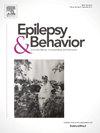Stratifying cognitive and behavioral comorbidities in children with new-onset seizures – The influence of sociodemographic disadvantage
IF 2.3
3区 医学
Q2 BEHAVIORAL SCIENCES
引用次数: 0
Abstract
Rationale
Children with new-onset epilepsy often experience co-morbid cognitive and behavioral challenges, which can be influenced by Social Determinants Of Health (SDOH) such as household income and parental education level. Although unsupervised machine learning has identified distinct cognitive and behavioral phenotypes at or near diagnosis, the relationship between these clusters remains underexplored. This study aims to examine the relationship between cognitive and behavioral clusters and the impact of SDOH among children with new-onset seizures.
Methods
We recruited 312 children (ages 6–16) within six weeks of their first recognized seizure. Each participant underwent a comprehensive neuropsychological assessment, from which factor analysis identified four primary domains: language, processing speed, executive function, and verbal memory. Parents also completed the Child’s Behavior Checklist (CBCL). K-means cluster analysis was applied to the mean factor scores and CBCL T-scores to identify unique clusters. We assessed SDOH factors, including maternal education level, child’s race, household income, and parental marital status, along with clinical epilepsy characteristics such as age at seizure onset, seizure frequency/intensity, seizure syndrome, MRI/EEG abnormalities, and neurologic examination findings to distinguish these clusters.
Results
We identified two primary clusters within both cognitive and behavioral scores: Resilient and At-Risk. Children in the Resilient Cognitive Cluster exhibited fewer behavioral problems, while those in the Resilient Behavior Cluster demonstrated higher cognitive performance. Conversely, the At-Risk Cognitive Cluster was associated with greater behavioral problems, and the At-Risk Behavior Cluster correlated with lower cognitive performance. Notably, almost two-thirds of participants showed congruence in clustering, either displaying resilience in both cognition and behavior or vulnerability in both domains. Resilient children exhibited lower levels of sociodemographic disadvantage, whereas those in the At-Risk Clusters faced significant disadvantages. Sociodemographic factors were more pronounced in differentiating clusters compared to traditional clinical epilepsy characteristics.
Conclusions
Among children with new-onset seizures, some display significant resilience to multimorbidities, while others are particularly vulnerable to neurobehavioral challenges, often linked to sociodemographic disadvantages. Future research should explore whether early interventions targeting SDOH can mitigate these risks and improve outcomes for children with new-onset epilepsy.
求助全文
约1分钟内获得全文
求助全文
来源期刊

Epilepsy & Behavior
医学-行为科学
CiteScore
5.40
自引率
15.40%
发文量
385
审稿时长
43 days
期刊介绍:
Epilepsy & Behavior is the fastest-growing international journal uniquely devoted to the rapid dissemination of the most current information available on the behavioral aspects of seizures and epilepsy.
Epilepsy & Behavior presents original peer-reviewed articles based on laboratory and clinical research. Topics are drawn from a variety of fields, including clinical neurology, neurosurgery, neuropsychiatry, neuropsychology, neurophysiology, neuropharmacology, and neuroimaging.
From September 2012 Epilepsy & Behavior stopped accepting Case Reports for publication in the journal. From this date authors who submit to Epilepsy & Behavior will be offered a transfer or asked to resubmit their Case Reports to its new sister journal, Epilepsy & Behavior Case Reports.
 求助内容:
求助内容: 应助结果提醒方式:
应助结果提醒方式:


